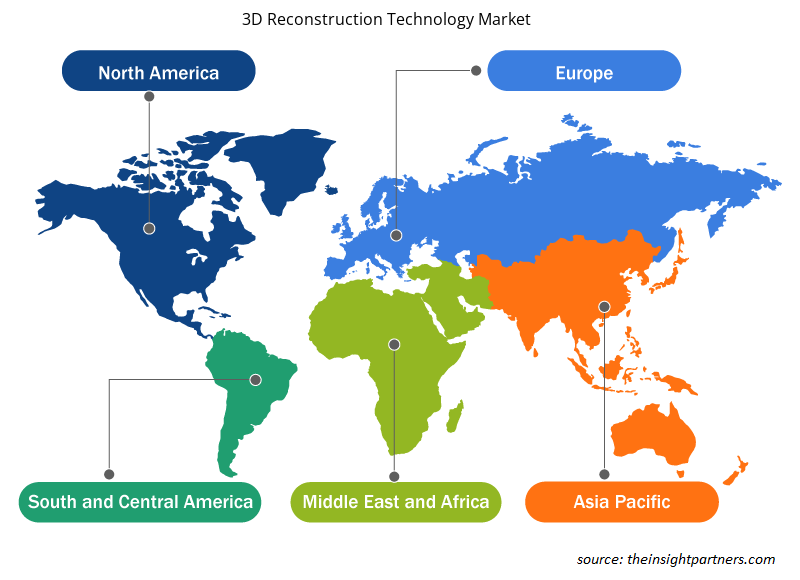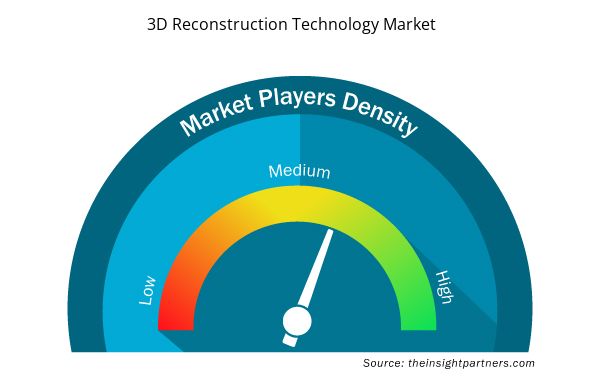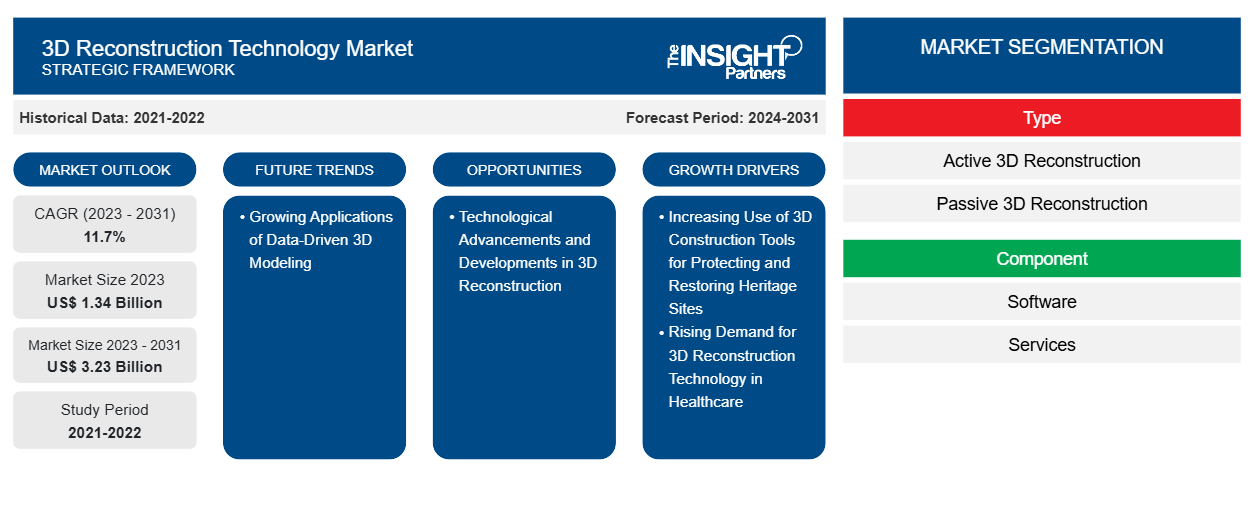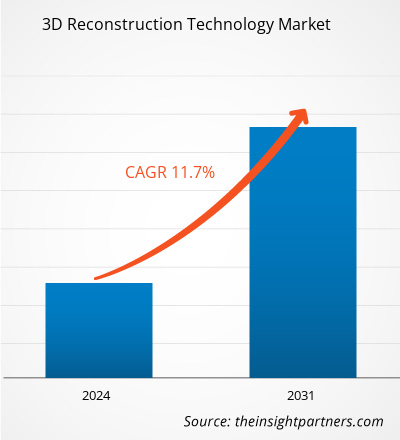Das Marktvolumen für 3D-Rekonstruktionstechnologie soll von 1,34 Milliarden US-Dollar im Jahr 2023 auf 3,23 Milliarden US-Dollar im Jahr 2031 anwachsen. Für den Markt wird für den Zeitraum 2023–2031 eine durchschnittliche jährliche Wachstumsrate (CAGR) von 11,7 % erwartet.
Die zunehmende Anwendung datenbasierter 3D-Modellierung wird voraussichtlich auch weiterhin ein wichtiger Markttrend in der 3D-Rekonstruktionstechnologie bleiben.
Marktanalyse für 3D-Rekonstruktionstechnologie
3D-Rekonstruktion ist eine Technik, bei der ein Computer verwendet wird, um einen Gegenstand in einer virtuellen 3D-Umgebung nachzubilden. Es handelt sich um einen wachsenden Bereich der Computervision, der durch Augmented Reality (AR) und Virtual Reality (VR) immer gefragter wird. Die Technologie ermöglicht es Benutzern, beim Einkaufen in AR und VR virtuell Kleidung anzuprobieren und medizinische Bilddaten zu verarbeiten. Sie kann auch für die Videorekonstruktion mit freiem Blickwinkel, Robotermapping, Reverse Engineering und sogar zum Wiedererleben bemerkenswerter Momente aus verschiedenen Perspektiven verwendet werden.
Marktübersicht für 3D-Rekonstruktionstechnologie
Bei der 3D-Rekonstruktionstechnologie handelt es sich um einen Prozess zur Darstellung der Form und des Äußeren realer Objekte. Dieser Prozess kann entweder mit aktiven oder passiven Methoden durchgeführt werden. Aktive Methoden wie strukturiertes Licht, Laser-Entfernungsmesser und andere aktive Sensortechniken greifen aktiv in das rekonstruierte Objekt ein, um die Tiefenkarte zu erhalten. Passive Methoden hingegen greifen nicht in das rekonstruierte Objekt ein, da sie nur einen Sensor verwenden, um die von der Oberfläche des Objekts abgegebene oder reflektierte Strahlung auszuwerten, um durch Bildverständnis auf seine 3D-Struktur zu schließen. Die Technologie umfasst Tools, die einen dreidimensionalen Rahmen für den jeweiligen Vorgang oder das Produkt bieten. Der Markt wird durch die zunehmende Verwendung von Videospielen und Kinofilmen im Unterhaltungssektor und die steigende Nachfrage nach medizinischer Bildgebung und technischen Fortschritten angetrieben. Darüber hinaus hat die Forschung zur 3D-Rekonstruktionstechnologie auf Basis von Lasermessungen gezeigt, dass sie einfach und genau ist, was nicht nur die 3D-Rekonstruktion kleiner Teile effektiv fördert, sondern auch auf intelligentes Fahren, unbemannte Luftfahrzeuge, künstliche Intelligenz, virtuelle Realität und andere verwandte Technologien angewendet werden kann.
Passen Sie diesen Bericht Ihren Anforderungen an
Sie erhalten kostenlos individuelle Anpassungen an jedem Bericht, einschließlich Teilen dieses Berichts oder einer Analyse auf Länderebene, eines Excel-Datenpakets sowie tolle Angebote und Rabatte für Start-ups und Universitäten.
- Holen Sie sich die wichtigsten Markttrends aus diesem Bericht.Dieses KOSTENLOSE Beispiel umfasst eine Datenanalyse von Markttrends bis hin zu Schätzungen und Prognosen.
Markttreiber und Chancen für 3D-Rekonstruktionstechnologie
Zunehmender Einsatz von 3D-Konstruktionswerkzeugen zum Schutz und zur Restaurierung von Kulturdenkmälern zur Förderung des Marktes
Der zunehmende Einsatz von 3D-Konstruktionswerkzeugen zum Schutz und zur Restaurierung von Kulturdenkmälern ist einer der Haupttreiber für den Markt für 3D-Rekonstruktionstechnologie. Mit dem Aufkommen digitaler Möglichkeiten und neuer virtueller Ideen wie dem Metaverse ist es unerlässlich, Werkzeuge zu erhalten, die genaue 3D-Rekonstruktionen aus Bilddaten erstellen können. Die dreidimensionale Rekonstruktionstechnologie wird verwendet, um historische Denkmäler und Kulturdenkmäler unter Einsatz von Augmented Reality und Virtual Reality zu erhalten und wieder aufzubauen . Diese Technologie wird auch verwendet, um digitale Archive von Kulturdenkmälern zu erstellen, die für Forschungs-, Bildungs- und Tourismuszwecke verwendet werden können.
Technologische Fortschritte und Entwicklungen in der 3D-Rekonstruktion – eine Chance für den Markt
Die Notwendigkeit verbesserter Sicherheitsmaßnahmen in brandgefährdeten Gebäuden und engen Räumen treibt die steigende Nachfrage nach halogenfreien Kabeln voran. Diese Nachfrage wird von verschiedenen Faktoren beeinflusst, darunter der Notwendigkeit, die mit Brandgefahren in modernen Gebäudekonstruktionen verbundenen Risiken zu mindern. Moderne Gebäude verfügen oft über offene Verglasungsarchitektur, Zwischendecken und große Öffnungen, die die für einen effektiven Brandschutz erforderliche Abschottung beeinträchtigen können. Darüber hinaus tragen eine mangelhafte Regulierung und Durchsetzung von Bauvorschriften, unzureichende Brandschutzbestimmungen und fehlende Ressourcen für die Wartung aktiver Brandschutzsysteme zu unzureichenden Brandschutzbestimmungen in Gebäuden bei, was das Risiko für Leben und strukturelle Integrität erheblich erhöht.
Segmentierungsanalyse des Marktberichts zur 3D-Rekonstruktionstechnologie
Wichtige Segmente, die zur Ableitung der Marktanalyse für 3D-Rekonstruktionstechnologie beigetragen haben, sind Typ, Komponente, Bereitstellung, Unternehmensgröße und Endverbrauchsbranche.
- Je nach Typ ist der Markt in aktive 3D-Rekonstruktion und passive 3D-Rekonstruktion unterteilt. Das Segment der aktiven 3D-Rekonstruktion hatte im Jahr 2023 einen beträchtlichen Marktanteil.
- Nach Komponenten ist der Markt in Software und Dienstleistungen unterteilt. Das Softwaresegment hielt im Jahr 2023 einen erheblichen Marktanteil.
- Basierend auf der Bereitstellung ist der Markt in On-Premises und Cloud unterteilt. Das On-Premises-Segment wird voraussichtlich im Jahr 2023 einen erheblichen Marktanteil halten.
- Basierend auf der Unternehmensgröße ist der Markt in Großunternehmen und KMU segmentiert. Das Segment der Großunternehmen wird voraussichtlich im Jahr 2023 einen erheblichen Marktanteil halten.
- In Bezug auf die Endverbrauchsbranche ist der Markt in die Branchen Automobil, Bildung, Luft- und Raumfahrt und Verteidigung, Gesundheitswesen, Medien und Unterhaltung, Bauwesen und Architektur, Regierung und öffentliche Sicherheit und andere unterteilt. Das Gesundheitssegment wird voraussichtlich im Jahr 2023 einen erheblichen Marktanteil halten.
3D-Rekonstruktionstechnologie Marktanteilsanalyse nach Geografie
Der geografische Umfang des Marktberichts zur 3D-Rekonstruktionstechnologie ist hauptsächlich in fünf Regionen unterteilt: Nordamerika, Asien-Pazifik, Europa, Naher Osten und Afrika sowie Südamerika/Süd- und Mittelamerika.
Der Markt für 3D-Rekonstruktionstechnologie in Europa hat ein beträchtliches Wachstum erlebt und wird sich in den kommenden Jahren voraussichtlich weiter entwickeln. Die Region verfügt über anerkannte Branchenakteure mit einer langen Geschichte an technischer Expertise in der 3D-Technologie. Die meisten 3D-Technologieunternehmen haben ihren Sitz in Westeuropa. Zu den wichtigsten Unternehmen, die auf dem Markt für 3D-Rekonstruktionstechnologie in Europa tätig sind, gehören Autodesk Inc., Pix4D SA, Bentley Systems, Incorporated und Skyline Software Systems Inc. Diese Unternehmen spielen eine wichtige Rolle bei der Steuerung von Innovationen und technologischen Fortschritten im Bereich der 3D-Rekonstruktion. Europa dominiert den globalen Markt für 3D-Rekonstruktionstechnologie. Die gut entwickelte Infrastruktur der Region und die Regierungsinitiativen zur Erhaltung des kulturellen Erbes tragen zu seiner Dominanz auf dem Markt bei. Länder wie Deutschland, Frankreich, Großbritannien, Italien und Spanien tragen maßgeblich zum Wachstum des Marktes für 3D-Rekonstruktionstechnologie in Europa bei.
Marktnachrichten und aktuelle Entwicklungen zur 3D-Rekonstruktionstechnologie
Der Markt für 3D-Rekonstruktionstechnologie wird durch die Erfassung qualitativer und quantitativer Daten nach Primär- und Sekundärforschung bewertet, die wichtige Unternehmensveröffentlichungen, Verbandsdaten und Datenbanken umfasst. Im Folgenden finden Sie eine Liste der Entwicklungen auf dem Markt:
- Skyline Software Systems, Inc. – ein Anbieter von 3D-Erdvisualisierungssoftware und -diensten – hat sich mit PASCO Corporation zusammengetan, um TerraExplorer in Japan auf den Markt zu bringen. TerraExplorer ist eine 3D-GIS-Desktopanwendung, die eine hochauflösende 3D-Atmosphäre und Tools zum Anzeigen, Abfragen, Analysieren und Präsentieren georäumlicher Daten bietet. Die Anwendung verfügt über eine 3D-Rekonstruktionstechnologie, die die Genauigkeit der Ergebnisse verbessert. TerraExplorer kann in verschiedenen Bereichen eingesetzt werden, beispielsweise in der Stadt- und Verkehrsplanung, der öffentlichen Sicherheit, der Verteidigung und dem Geheimdienst, der Landwirtschaft, dem Bergbau und der Versorgungswirtschaft.
(Quelle: Skyline Software Systems, Inc., Pressemitteilung, 2022)
Regionale Einblicke in den Markt für 3D-Rekonstruktionstechnologie
Die regionalen Trends und Faktoren, die den Markt für 3D-Rekonstruktionstechnologie während des gesamten Prognosezeitraums beeinflussen, wurden von den Analysten von Insight Partners ausführlich erläutert. In diesem Abschnitt werden auch Marktsegmente und Geografien für 3D-Rekonstruktionstechnologie in Nordamerika, Europa, im asiatisch-pazifischen Raum, im Nahen Osten und Afrika sowie in Süd- und Mittelamerika erörtert.

- Erhalten Sie regionale Daten zum Markt für 3D-Rekonstruktionstechnologie
Umfang des Marktberichts zur 3D-Rekonstruktionstechnologie
| Berichtsattribut | Details |
|---|---|
| Marktgröße im Jahr 2023 | 1,34 Milliarden US-Dollar |
| Marktgröße bis 2031 | 3,23 Milliarden US-Dollar |
| Globale CAGR (2023 - 2031) | 11,7 % |
| Historische Daten | 2021-2022 |
| Prognosezeitraum | 2024–2031 |
| Abgedeckte Segmente | Nach Typ
|
| Abgedeckte Regionen und Länder | Nordamerika
|
| Marktführer und wichtige Unternehmensprofile |
|
Marktteilnehmerdichte: Der Einfluss auf die Geschäftsdynamik
Der Markt für 3D-Rekonstruktionstechnologie wächst rasant, angetrieben durch die steigende Nachfrage der Endnutzer aufgrund von Faktoren wie sich entwickelnden Verbraucherpräferenzen, technologischen Fortschritten und einem größeren Bewusstsein für die Vorteile des Produkts. Mit steigender Nachfrage erweitern Unternehmen ihr Angebot, entwickeln Innovationen, um die Bedürfnisse der Verbraucher zu erfüllen, und nutzen neue Trends, was das Marktwachstum weiter ankurbelt.
Die Marktteilnehmerdichte bezieht sich auf die Verteilung der Firmen oder Unternehmen, die in einem bestimmten Markt oder einer bestimmten Branche tätig sind. Sie gibt an, wie viele Wettbewerber (Marktteilnehmer) in einem bestimmten Marktraum im Verhältnis zu seiner Größe oder seinem gesamten Marktwert präsent sind.
Die wichtigsten auf dem Markt für 3D-Rekonstruktionstechnologie tätigen Unternehmen sind:
- Autodesk Inc.
- EOS-Bildgebung
- Intel Corporation
- Koninklijke Philips NV
- PhotoModeler-Technologien
- Pix4D SA
Haftungsausschluss : Die oben aufgeführten Unternehmen sind nicht in einer bestimmten Reihenfolge aufgeführt.

- Erhalten Sie einen Überblick über die wichtigsten Akteure auf dem Markt für 3D-Rekonstruktionstechnologie
Marktbericht zur 3D-Rekonstruktionstechnologie – Abdeckung und Ergebnisse
Der Bericht „Marktgröße und Prognose für 3D-Rekonstruktionstechnologie (2021–2031)“ bietet eine detaillierte Analyse des Marktes, die die folgenden Bereiche abdeckt:
- Marktgröße und Prognose auf globaler, regionaler und Länderebene für alle wichtigen Marktsegmente, die im Rahmen des Projekts abgedeckt sind
- Marktdynamik wie Treiber, Beschränkungen und wichtige Chancen
- Wichtige Zukunftstrends
- Detaillierte PEST/Porters Five Forces- und SWOT-Analyse
- Globale und regionale Marktanalyse mit wichtigen Markttrends, wichtigen Akteuren, Vorschriften und aktuellen Marktentwicklungen
- Branchenlandschaft und Wettbewerbsanalyse, einschließlich Marktkonzentration, Heatmap-Analyse, prominenten Akteuren und aktuellen Entwicklungen
- Detaillierte Firmenprofile
- Historische Analyse (2 Jahre), Basisjahr, Prognose (7 Jahre) mit CAGR
- PEST- und SWOT-Analyse
- Marktgröße Wert/Volumen – Global, Regional, Land
- Branche und Wettbewerbsumfeld
- Excel-Datensatz



Report Coverage
Revenue forecast, Company Analysis, Industry landscape, Growth factors, and Trends

Segment Covered
This text is related
to segments covered.

Regional Scope
North America, Europe, Asia Pacific, Middle East & Africa, South & Central America

Country Scope
This text is related
to country scope.
Häufig gestellte Fragen
The market was estimated to be US$ 1.34 billion in 2023 and is expected to grow at a CAGR of 11.7% during the period 2023 - 2031.
The increasing use of 3D construction tools for protecting & restoring heritage sites and the rising demand for 3D reconstruction technology in healthcare are the major factors that propel the market.
The market is expected to reach US$ 3.23 billion by 2031.
Growing applications of data-driven 3D modeling are anticipated to play a significant role in the market in the coming years.
The key players holding significant shares in the market are Autodesk Inc., Intel Corporation, Koninklijke Philips N.V., Epic Games, Inc., and Thermo Fisher Scientific Inc.
Trends and growth analysis reports related to Technology, Media and Telecommunications : READ MORE..
The List of Companies - 3D Reconstruction Technology Market
- Autodesk Inc.
- EOS imaging
- Intel Corporation
- Koninklijke Philips N.V.
- PhotoModeler Technologies
- Pix4D SA
- Epic Games, Inc.
- Skyline Software Systems Inc.
- Thermo Fisher Scientific Inc.
- Agisoft
The Insight Partners performs research in 4 major stages: Data Collection & Secondary Research, Primary Research, Data Analysis and Data Triangulation & Final Review.
- Data Collection and Secondary Research:
As a market research and consulting firm operating from a decade, we have published and advised several client across the globe. First step for any study will start with an assessment of currently available data and insights from existing reports. Further, historical and current market information is collected from Investor Presentations, Annual Reports, SEC Filings, etc., and other information related to company’s performance and market positioning are gathered from Paid Databases (Factiva, Hoovers, and Reuters) and various other publications available in public domain.
Several associations trade associates, technical forums, institutes, societies and organization are accessed to gain technical as well as market related insights through their publications such as research papers, blogs and press releases related to the studies are referred to get cues about the market. Further, white papers, journals, magazines, and other news articles published in last 3 years are scrutinized and analyzed to understand the current market trends.
- Primary Research:
The primarily interview analysis comprise of data obtained from industry participants interview and answers to survey questions gathered by in-house primary team.
For primary research, interviews are conducted with industry experts/CEOs/Marketing Managers/VPs/Subject Matter Experts from both demand and supply side to get a 360-degree view of the market. The primary team conducts several interviews based on the complexity of the markets to understand the various market trends and dynamics which makes research more credible and precise.
A typical research interview fulfils the following functions:
- Provides first-hand information on the market size, market trends, growth trends, competitive landscape, and outlook
- Validates and strengthens in-house secondary research findings
- Develops the analysis team’s expertise and market understanding
Primary research involves email interactions and telephone interviews for each market, category, segment, and sub-segment across geographies. The participants who typically take part in such a process include, but are not limited to:
- Industry participants: VPs, business development managers, market intelligence managers and national sales managers
- Outside experts: Valuation experts, research analysts and key opinion leaders specializing in the electronics and semiconductor industry.
Below is the breakup of our primary respondents by company, designation, and region:

Once we receive the confirmation from primary research sources or primary respondents, we finalize the base year market estimation and forecast the data as per the macroeconomic and microeconomic factors assessed during data collection.
- Data Analysis:
Once data is validated through both secondary as well as primary respondents, we finalize the market estimations by hypothesis formulation and factor analysis at regional and country level.
- Macro-Economic Factor Analysis:
We analyse macroeconomic indicators such the gross domestic product (GDP), increase in the demand for goods and services across industries, technological advancement, regional economic growth, governmental policies, the influence of COVID-19, PEST analysis, and other aspects. This analysis aids in setting benchmarks for various nations/regions and approximating market splits. Additionally, the general trend of the aforementioned components aid in determining the market's development possibilities.
- Country Level Data:
Various factors that are especially aligned to the country are taken into account to determine the market size for a certain area and country, including the presence of vendors, such as headquarters and offices, the country's GDP, demand patterns, and industry growth. To comprehend the market dynamics for the nation, a number of growth variables, inhibitors, application areas, and current market trends are researched. The aforementioned elements aid in determining the country's overall market's growth potential.
- Company Profile:
The “Table of Contents” is formulated by listing and analyzing more than 25 - 30 companies operating in the market ecosystem across geographies. However, we profile only 10 companies as a standard practice in our syndicate reports. These 10 companies comprise leading, emerging, and regional players. Nonetheless, our analysis is not restricted to the 10 listed companies, we also analyze other companies present in the market to develop a holistic view and understand the prevailing trends. The “Company Profiles” section in the report covers key facts, business description, products & services, financial information, SWOT analysis, and key developments. The financial information presented is extracted from the annual reports and official documents of the publicly listed companies. Upon collecting the information for the sections of respective companies, we verify them via various primary sources and then compile the data in respective company profiles. The company level information helps us in deriving the base number as well as in forecasting the market size.
- Developing Base Number:
Aggregation of sales statistics (2020-2022) and macro-economic factor, and other secondary and primary research insights are utilized to arrive at base number and related market shares for 2022. The data gaps are identified in this step and relevant market data is analyzed, collected from paid primary interviews or databases. On finalizing the base year market size, forecasts are developed on the basis of macro-economic, industry and market growth factors and company level analysis.
- Data Triangulation and Final Review:
The market findings and base year market size calculations are validated from supply as well as demand side. Demand side validations are based on macro-economic factor analysis and benchmarks for respective regions and countries. In case of supply side validations, revenues of major companies are estimated (in case not available) based on industry benchmark, approximate number of employees, product portfolio, and primary interviews revenues are gathered. Further revenue from target product/service segment is assessed to avoid overshooting of market statistics. In case of heavy deviations between supply and demand side values, all thes steps are repeated to achieve synchronization.
We follow an iterative model, wherein we share our research findings with Subject Matter Experts (SME’s) and Key Opinion Leaders (KOLs) until consensus view of the market is not formulated – this model negates any drastic deviation in the opinions of experts. Only validated and universally acceptable research findings are quoted in our reports.
We have important check points that we use to validate our research findings – which we call – data triangulation, where we validate the information, we generate from secondary sources with primary interviews and then we re-validate with our internal data bases and Subject matter experts. This comprehensive model enables us to deliver high quality, reliable data in shortest possible time.


 Holen Sie sich ein kostenloses Muster für diesen Bericht
Holen Sie sich ein kostenloses Muster für diesen Bericht